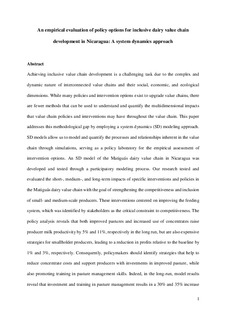| dc.contributor.author | Lie, Helene | |
| dc.contributor.author | Rich, Karl M. | |
| dc.contributor.author | Hoek, Rein van der | |
| dc.contributor.author | Dizyee, Kanar | |
| dc.date.accessioned | 2018-06-29T12:33:12Z | |
| dc.date.available | 2018-06-29T12:33:12Z | |
| dc.date.created | 2018-06-20T10:09:31Z | |
| dc.date.issued | 2018 | |
| dc.identifier.citation | Agricultural Systems. 2018, 164 193-222. | nb_NO |
| dc.identifier.issn | 0308-521X | |
| dc.identifier.uri | http://hdl.handle.net/11250/2503813 | |
| dc.description.abstract | Achieving inclusive value chain development is a challenging task due to the complex and dynamic nature of interconnected value chains and their social, economic, and ecological dimensions. While many policies and intervention options exist to upgrade value chains, there are fewer methods that can be used to understand and quantify the multidimensional impacts that value chain policies and interventions may have throughout the value chain. This paper addresses this methodological gap by employing a system dynamics (SD) modeling approach. SD models allow us to model and quantify the processes and relationships inherent in the value chain through simulations, serving as a policy laboratory for the empirical assessment of intervention options. An SD model of the Matiguás dairy value chain in Nicaragua was developed and tested through a participatory modeling process. Our research tested and evaluated the short-, medium-, and long-term impacts of specific interventions and policies in the Matiguás dairy value chain with the goal of strengthening the competitiveness and inclusion of small- and medium-scale producers. These interventions centered on improving the feeding system, which was identified by stakeholders as the critical constraint to competitiveness. The policy analysis reveals that both improved pastures and increased use of concentrates raise producer milk productivity by 5% and 11%, respectively in the long run, but are also expensive strategies for smallholder producers, leading to a reduction in profits relative to the baseline by 1% and 3%, respectively. Consequently, policymakers should identify strategies that help to reduce concentrate costs and support producers with investments in improved pasture, while also promoting training in pasture management skills. Indeed, in the long-run, model results reveal that investment and training in pasture management results in a 30% and 35% increase in milk production during the wet and dry season, respectively. Simulation results further highlighted that intensifying the feeding system to improve cow milk yields is mainly profitable in the long term, and thus requires a longer-term perspective by policymakers. The model provides a deeper understanding of the complex and dynamic nature of the Matiguás dairy value chain and the interactions between markets, coordination aspects, biophysical phenomena, and income. The system dynamics approach to value chain analysis further addresses a major analytical shortcoming in value chain analysis and provides decision makers with an improved platform for planning and policy formulation. | |
| dc.description.abstract | An empirical evaluation of policy options for inclusive dairy value chain development in Nicaragua: A system dynamics approach | |
| dc.language.iso | eng | nb_NO |
| dc.relation.uri | https://www.sciencedirect.com/science/article/pii/S0308521X1730392X | |
| dc.rights | Attribution-NonCommercial-NoDerivatives 4.0 Internasjonal | * |
| dc.rights.uri | http://creativecommons.org/licenses/by-nc-nd/4.0/deed.no | * |
| dc.title | An empirical evaluation of policy options for inclusive dairy value chain development in Nicaragua: A system dynamics approach | nb_NO |
| dc.title.alternative | An empirical evaluation of policy options for inclusive dairy value chain development in Nicaragua: A system dynamics approach | nb_NO |
| dc.type | Journal article | nb_NO |
| dc.type | Peer reviewed | nb_NO |
| dc.description.version | acceptedVersion | |
| dc.source.pagenumber | 193-222 | nb_NO |
| dc.source.volume | 164 | nb_NO |
| dc.source.journal | Agricultural Systems | nb_NO |
| dc.identifier.doi | 10.1016/j.agsy.2018.03.008 | |
| dc.identifier.cristin | 1592527 | |
| dc.relation.project | Norges forskningsråd: 239514 | nb_NO |
| dc.relation.project | Andre: CGIAR, project # GHCE-2015-142 | nb_NO |
| cristin.unitcode | 192,13,1,0 | |
| cristin.unitname | Institutt for internasjonale miljø- og utviklingsstudier | |
| cristin.ispublished | true | |
| cristin.fulltext | postprint | |
| cristin.qualitycode | 1 | |

